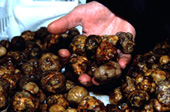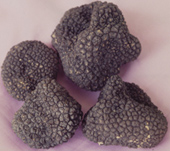
Truffles and mushrooms (Consulting) Limited
© Truffles and Mushrooms (Consulting) Ltd
The cultivation of truffles
Joseph Talon, who lived in France during the first part of the 18th Century, discovered that if self-sown seedlings growing under a Périgord black truffle producing oak were used to establish truffle plantations (truffières) eventually they might also produce truffles. Unfortunately, Talon's plants were often contaminated by other soil flora and fauna, including other potentially competing ectomycorrhizal fungi and consequently many never produced truffles.
In the 1960s and 1970s new methods were devised to infect plants with the Périgord black truffle (Tuber melanosporum), the bianchetto truffle (Tuber borchii), and the Burgundy truffle (Tuber aestivum) so that now dozens of nurseries around the world produce seedlings inoculated with various species of truffle. Even so, very often these truffle plants are contaminated with other ectomycorrhizal fungi, including species of truffle with very poor culinary properties, that later may compete with the truffle mycelium for space on the host's roots in the field. Consequently, a potential truffle grower should be very careful where they buy their truffle infected plants. The prospective truffle grower should also be aware that there is an important difference between a plant that is said to be inoculated with a species of truffle (i.e., the fungus has been applied to the roots) and a plant that is well infected solely with the correct species of truffle.
A prospective grower of truffles can have considerable control over whether their plantation will be successful or not. Some factors that they need to consider include the climate where they intend establishing their truffière, whether the soil has the right physical and chemical characteristics and if the application of lime is required, the ideal layout of the truffière, irrigation equipment and maintenance. Of paramount importance is the need to use plants with the right species of fungus on the roots. Don’t trust what the nurseryman tells you - get the plants independently tested by a company like dnature who conduct DNA tests on samples of root and tell you exactly what is on them. It makes little sense to use poor quality plants, look after them for perhaps 10 years and then find out that the right truffle was probably not on the root system to begin with!
A good starting point is to read one of the comprehensive books and reports that have been written on the cultivation of truffles and some of the information available on the web. Then it is always wise to consult a specialist - it can be what you haven't thought about that may make the difference between success and failure years into the future.
In the 1960s and 1970s new methods were devised to infect plants with the Périgord black truffle (Tuber melanosporum), the bianchetto truffle (Tuber borchii), and the Burgundy truffle (Tuber aestivum) so that now dozens of nurseries around the world produce seedlings inoculated with various species of truffle. Even so, very often these truffle plants are contaminated with other ectomycorrhizal fungi, including species of truffle with very poor culinary properties, that later may compete with the truffle mycelium for space on the host's roots in the field. Consequently, a potential truffle grower should be very careful where they buy their truffle infected plants. The prospective truffle grower should also be aware that there is an important difference between a plant that is said to be inoculated with a species of truffle (i.e., the fungus has been applied to the roots) and a plant that is well infected solely with the correct species of truffle.
A prospective grower of truffles can have considerable control over whether their plantation will be successful or not. Some factors that they need to consider include the climate where they intend establishing their truffière, whether the soil has the right physical and chemical characteristics and if the application of lime is required, the ideal layout of the truffière, irrigation equipment and maintenance. Of paramount importance is the need to use plants with the right species of fungus on the roots. Don’t trust what the nurseryman tells you -
A good starting point is to read one of the comprehensive books and reports that have been written on the cultivation of truffles and some of the information available on the web. Then it is always wise to consult a specialist -
Bencivenga, M.; Vignozzi, G. 1989. Il tartufi in Toscana. Vantaggio, Firenza.
Chevalier, G.; Frochot, H. 1997. La Truffe de Bourgogne. Pétrarque, Levallois-Perret.
Garcia-Falces, R.S.; De Miguel-Velasco, A.-M. 1995. Guia practica de truficultura. Agricola, Pamplona.
Hall, I.R.; Brown, G.; Zambonelli,A. 2007. Taming the Truffle: the history, lore, and science of the ultimate mushroom. Timber Press, Portland. 304 p.
Hall, I.R.; Brown, G.; Zambonelli, A. 2009. Trufas: historia, ciencia, cultivo y recolección : con las últimas investigaciones y experiencias. Madrid, Tutor.
Hall, I.R.; Dixon, C.A.; Parmenter, G.A.; Martin, N.; Hance-Halloy, M.L. 200 2 Factors affecting fruiting of the Périgord black truffle: a comparison of productive and non productive Tuber melanosporum truffières in New Zealand Crop & Food Research Confidential report No. 768 (available only to members of the New Zealand Truffle Association).
Hall, I.R.; Stephenson, S.; Buchanan, P.; Wang, Y.; Cole, A.L.J. 2003. Edible and poisonous mushrooms of the world. Timber Press, Portland. 371 p.
Zambonelli, A.; Bonito, G.M. (Eds) 2012. Edible ectomycorrhizal mushrooms. Dordrecht, Springer.
Olivier, J.-M.; Savignac, J.-C.; Sourzat, P. 2002: Truffe et trufficulteur. Fanlac, Périgueux.
Reyna-Domenech, S. 2007. Truficultura: Fundamentos y Técnicas. Mundi-Prensa, Madrid.
Ricard, J.-M. 2003. La truffe: guide technique. CTIFL, Paris.
Sourzat, P. 2002. Guide pratique de trufficulture. Lacoste, Le Montat, France.
Chevalier, G.; Frochot, H. 1997. La Truffe de Bourgogne. Pétrarque, Levallois-
Garcia-
Hall, I.R.; Brown, G.; Zambonelli,A. 2007. Taming the Truffle: the history, lore, and science of the ultimate mushroom. Timber Press, Portland. 304 p.
Hall, I.R.; Brown, G.; Zambonelli, A. 2009. Trufas: historia, ciencia, cultivo y recolección : con las últimas investigaciones y experiencias. Madrid, Tutor.
Hall, I.R.; Dixon, C.A.; Parmenter, G.A.; Martin, N.; Hance-
Hall, I.R.; Stephenson, S.; Buchanan, P.; Wang, Y.; Cole, A.L.J. 2003. Edible and poisonous mushrooms of the world. Timber Press, Portland. 371 p.
Zambonelli, A.; Bonito, G.M. (Eds) 2012. Edible ectomycorrhizal mushrooms. Dordrecht, Springer.
Olivier, J.-
Reyna-
Ricard, J.-
Sourzat, P. 2002. Guide pratique de trufficulture. Lacoste, Le Montat, France.
For more references on the cultivation of truffles click here.
Bianchetto truffle - an excellent truffle with an expanding market.
Burgundy truffles - a good species of truffle widely consumed in France and Italy. This species might be confused with the Périgord black truffle.

